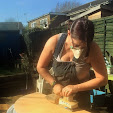 Today, my team attended an Articulate workshop, run by my colleague, Mark Berthelemy. I've done some work with Articulate before, so, while I picked up all sorts of little bits and pieces, I didn't learn anything earth shatteringly new in that respect.
Today, my team attended an Articulate workshop, run by my colleague, Mark Berthelemy. I've done some work with Articulate before, so, while I picked up all sorts of little bits and pieces, I didn't learn anything earth shatteringly new in that respect.
Ironically, I pushed the boundaries on my knowledge of an app that I know extremely well. An app on which I ran training courses for so long during my years as an IT trainer, that I can't even remember when it started. A little thing called PowerPoint, with which I have a love/hate relationship. I love what I can achieve with PowerPoint. I hate being subjected to what some people are pleased to call PowerPoint presentations. And if I never see another bullet point again it will be too soon!
But I digress.
One thing I learned today, which was totally incidental to the issue at hand, was how to use the "drawing" feature in PowerPoint (or Word, or any of a myriad other apps for that matter) to draw a very realistic looking 3-D marble. The lesson was being used as an example of passive learning that is still engaging. It certainly proved to be so because, when Mark felt that he had made his point and wanted to continue with the Articulate workshop, I wouldn't let him! I h ad to see it through.
ad to see it through.
Then I came home and showed off my new skill to my husband and taught my sons how to draw marbles.
So I may well have lost my marbles, but it seems I can just draw myself a whole bag of new ones.
Okay, so I'm never going to conquer the world with this new found skill, and it isn't going to move my career forward any time soon, but I'm having fun... and tell me you're not secretly impressed by my marbles!
Saturday, February 02, 2008
I learned to draw a marble!
Subscribe to:
Post Comments (Atom)


3 comments:
I'm impressed! It looks like there are basically three parts to this image:
1. The main colored circle
2. The top reflection, which looks like an oval with a gradient from white to transparent
3. The lower reflection--maybe a radial gradient, white in the center to transparent outside? Is it a circle?
Now you have to share how to do it!
I'm impressed, so how do you do it?
Well done, Christy! For some reason, the background gets saved in negative when you save an image as a picture from PowerPoint, but here goes:
1. Create your circle (tip: for perfect circles, hold down the shift key while drawing the shape with the mouse).
2. Remove the line from the edge of the circle
3. Shade the circle using the fille effects. Opt for a single colour, but go for the shading that goes from dark at the top to light at the bottom
4. Create an oval which, as Christy spotted is graded from white at the top to transparent at the bottom.
5. Superimpose the oval near the top of the original circle.
6. Now, it is this next bit that adds the final touch and makes the shape come alive. Duplicate the original circle.
7. Change its colour to white
8. Use fill effects to shade it "from centre", but set it so that it goes from opaque in the centre to transparent on the outside. Obviously, you also want the grey shading in the centre.
9. Place the new circle so that its centre falls on the lowest point of the circumference of the first circle.
10. Use "order" to send the new circle to the back. Feast your eyes!
11. This is an optional step - group the three shapes together.
Now you can resize the shape as you choose (tip: hold down the shift key to retain the integrity of the shape).
They make fantastic bullet points!
Post a Comment